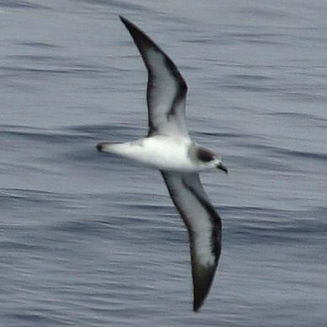|
Pterodroma baraui (Barau’s
petrel)
Baraustormvoël [Afrikaans]; Barau-stormvogel [Dutch];
Diablotin de Barau [French]; Barau-sturmvogel [German]
Life
> Eukaryotes >
Opisthokonta
> Metazoa (animals) >
Bilateria >
Deuterostomia > Chordata >
Craniata > Vertebrata (vertebrates) > Gnathostomata (jawed
vertebrates) > Teleostomi (teleost fish) > Osteichthyes (bony fish) > Class:
Sarcopterygii (lobe-finned
fish) > Stegocephalia (terrestrial
vertebrates) > Tetrapoda
(four-legged vertebrates) > Reptiliomorpha > Amniota >
Reptilia (reptiles) >
Romeriida > Diapsida > Archosauromorpha > Archosauria >
Dinosauria
(dinosaurs) > Saurischia > Theropoda (bipedal predatory dinosaurs) >
Coelurosauria > Maniraptora > Aves
(birds) > Order: Ciconiiformes
> Family: Procellariidae
 |
|
|
Barau's petrel, offshore from Richard's Bay, South Africa. [photo
Trevor Hardaker ©] |
|
Distribution and habitat
Breeds on Réunion Island and possibly some islands near
Mauritius, after which it disperses across the Indian Ocean from 41° South to
11° North. It is a rare vagrant to southern African waters, with three records:
one off southern Mozambique in November 1987, and another two records off
Richard's Bay, KwaZulu-Natal in 1988 and 2003 respectively.
Movements and migrations
It arrives at its breeding colonies in
September, after which it is thought disperse and head north in the
period from June-August, returning again between December and
February.
Food
It does most of its foraging by snatching prey from the
water surface, often in flocks with other seabirds, such as
Tropical and
Wedge-tailed shearwaters,
Sooty terns and
Brown noddies.
Threats
Endangered, due to its small population of just
4000-5000 pairs, coupled with decreases in breeding colony size due to illegal
exploitation and predation by introduced rats, cats and goats.
References
-
Hockey PAR, Dean WRJ and Ryan PG 2005. Roberts
- Birds of southern Africa, VIIth ed. The Trustees of the John Voelcker
Bird Book Fund, Cape Town
|
